Nuku Hiva
Nuku Hiva is approximately 85 miles from Tahuata. To enable for us to arrive in daylight, we decided to leave Tahuata at around 5pm and do an overnight sail. We had a very pleasant downwind sail with winds between 10-15 knots, using just the genoa. As dark fell, we could see some navigation lights ahead of us and could see from the AIS that they belonged to a catamaran called Making Memories. The catamaran remained ahead of us until 2 hours before we arrived in Nuku Hiva, when we slowly crept ahead of them. We arrived in Taiohae Bay at around 8.30am, closely followed by Making Memories, who anchored close by.
The anchorage was busy but the bay is huge, so there was lots of room for everyone to have plenty of swinging room. Friends had warned us that the swell often makes its way into the bay making it rolly and uncomfortable, but it wasn't too bad as we arrived. We were both tired after our night sail, so we set the anchor drag alarm, had some breakfast and took a nap. We would leave going ashore until the following day.
Early next morning we ventured ashore, taking our rubbish with us. We had two large bags, as there were no facilities to dispose of rubbish in either Fatu Hiva or where we were in Tahuata. The dock was a concrete wall with two sets of steps reaching down into the water. The rise and fall of tide was a good metre so the steps were needed to be able to get ashore. Due to the amount of boats in the anchorage, there were a lot of dinghies at the dock too. Reaching a set of steps and getting off the dinghy was quite a challenge, having to push your way through a sea of dinghies. Add the surge from the swell and it was quite tricky, but what really focused our attention was the local fisherman feeding scraps to a swirling mass of sharks, a good incentive not to fall in the water! Fortunately, we managed to get ashore without injury or being eaten, and tie the rib to a securing ring on the side of the steps.
Right in front of the dock was Nuku Hiva Yacht Services, run by an American called Kevin, and his Marquesan wife Annabella. For 600 Polynesian Francs (approx £4.50) Kevin would provide a password for internet access, which was valid for 24 hours. We used this opportunity to catch up on emails, talk to the family and do a couple of blog updates. Sadly, the WIFI in these parts is very slow, so it took several days to get on top of things.
One thing we were keen to do was an island tour, to see some of the archaeological sights. We got chatting to Allen and Maria from yacht Lady Jane who had already done a tour, and they said it was well worth doing. Talking later to Jeff and Debbie on Making Memories, we discovered they were keen to do a tour too and asked if they could join us. We asked Kevin if a tour was something he could arrange, as when we went to the Tourist Information Office, it was closed, so we couldn't arrange one there. Luckily, Kevin managed to arrange a tour for the following day with a local man called Richard.
The following day, Richard picked the four of us up in his jeep at 8.30am. He told us he was going to pick up a French couple too, who were staying at one of the guest houses in the village. He had four seats inside the jeep and six in the back, undercover. We chose to sit in the back.
After picking up the French couple, we made our way out of the village and started the steep climb up Mount Muake, which is 864 metres high. We stopped at a viewpoint overlooking Taiohae Bay, where we took some photos and could see Azzy bobbing at anchor.
Whilst we were taking in the view, a local passed us on the road, taking his dog for a walk.
We then drove to Taipivai, to look down over Typee Bay. This bay was made famous by the Moby Dick authour, Herman Melville. In 1842, he arrived at Taiohae Bay on the whaling ship Acushnet, jumped ship, made his way to Taipivai and spent 3 weeks living amongst the Typee tribe. During his stay with the tribe, Melville thought he was going to be eaten as the Marquesans were cannibals at that time, so he made his escape, returned to Taiohae Bay and jumped on the first whaling ship that came through. Ironically, he was probably safe and the tribe would have adopted and looked after him well. Richard said this is because he was white and the colours white and red were sacred to the Marquesans. He later wrote the book "Typee: A Peep at Polynesian Life", based on his experience. As Lynne had read the book, she was interested to see the area.
From Taipivai, we made our way to Hooumi, which is nestled at the head of the three bays that make up Controleur Bay.
In the village there was a beautiful Marquesan church and we took a look inside. There were several woodcarvings of Jesus and the Virgin Mary inside, all made using different local woods. Each had a unique reference to Marquesan culture. For example, one of the statues of Jesus sees him holding a traditional carved axe and the Virgin Mary is carrying a Breadfruit, which has long been an important staple food for the Marquesans. A small stone carving is of the traditional Marquesan sign of the Cross. This was also displayed under the eaves of the the entrance to the church and in various other places.
Next, we made our way to Haticheu Bay on the north east of the island. We took the Teavaitapuhiva Pass and made a stop at the three connecting archaeological sites of Kamuihei, Tahakia and Teiipoka. Restoration of these sights began in 1998, by a team of archaeologists, led by Pierre Ottino. The sheer size of these sights shows how densely populated the valley once was. At Kauihei, there is a huge Banyan Tree, which is estimated to be over 600 years old. The Banyan tree was sacred to the ancient Marquesans and exuded Mona (spiritual power). In ancient times, the Marquesans did not bury their dead, but instead dried them or mummified them. With the dried bodies, they used the bones for tools and jewellery and the skulls were hung in the Banyan trees. It must have been quite a shocking sight for the early Missionaries to have seen, as each tree would have had over 100 skulls in it. The mummified bodies were carried up the sides of the mountain and placed in caves.
At the foot of the Banyan tree, there was a deep pit, which Richard called a 'bone hole'. He said taboo objects would have been thrown in there, and it is probably where they would have kept people who were to be sacrificed, prior to the act. They would have been bound to prevent them escaping.
Other holes were dotted around all over the sight and were mostly 'ua ma', which were used to stock the all-important Breadfuit. On some rock surfaces, there were small, deep holes which were formed by Breadfuit being tapped open to get to the flesh inside. They discovered shells at the site that they believe were used to scoop out the flesh.
On the Teiipoka site, two large rocks about 2.5 metres high, by 3 metres wide, are decorated with Petroglyphs that represent turtles, fish and the eyes of a tiki, along with human figures. It is thought that the valley contains more than 500 other petroglyphs like these. Petroglyphs are designs that are carved onto stones. No one is sure of their significance but some local experts believe they were ancient works of art.
In the Tahakia site is one of the largest Tohua in the Marquesas. The tohua is a paved rectangular platform with several tiers of basalt block rows on either side. They were used as meeting places and hosted festivals and dance performances. Flat boulders form a sort of platform on which solo dances took place. The site also has some 'Pae Pae'. These are platforms of stone blocks on which 'ha'e' (human habitations) were built from native plant and wood. The pae pae was divided into two sections. The front level was reserved for daily activities, while the back section, which was covered and slightly raised, served as a sleeping area. The roof was made from leaves from the Uru (Breadfruit) tree and coconut palm. Only the stone foundations have survived. The vegetation and wooden structures has been destroyed, but this site has reconstructed a few to show what a pae pae would have looked like.
We stopped in Haitheu Bay for a traditional Marquesan lunch at Chez Yvonne. Each meal was served with fried breadfruit balls and boiled Manioc, which is a type of vegetable similar to a potato. Haitheu was a pretty bay where one boat was at anchor. Richard pointed out a Rosewood tree. This is the type of wood the tiki we bought in Fatu Hiva is carved from.
Our last stop of the day was at the Hikokua archaeological site. This site was discovered in 1957 by archaeologist Robert Suggs. It has been restored and maintained by the locals since 1987. It was built around AD 1250 and was in use until the 1800's. The tohua is flanked by tiers of small flat basalt blocks that were once used as steps for the spectators. On the terrace are two modern stone carvings by a local artist.
A platform at the bottom was the 'tuu' (ceremonial activity centre), upon which sacrifices and displaying of the victims bodies took place. There is also another 'bone hole' in this platform.
We arrived back at Taiohae Bay at about 4pm. We all agreed it had been a very interesting day. Richard was an excellent guide who spoke faultless English. He was passionate about his island and its history. He was also very knowledgeable about local flora, fauna and bird life. We would highly recommend anyone visiting this beautiful island to make use of his services.
There are a few interesting things to see in Taiohae village itself, so we took a wander around the following day. On the waterfront is a Pae Pae called Piki Vehine, which was rebuilt for the 1989 Marquesas festival. The pae pae contains sculptures and tiki made by local sculptors and by artisans from Easter Island.
The Notre Dame Cathedral of the Marquesas Islands is set back from the main road. It is a striking building built from wood and stones on a former sacred site venerated by the ancient Marquesans. The stones come from the archipelago's six inhabited islands. Lynne went to Sunday mass at the cathedral as she was keen to hear some Polynesian singing. Out of respect, she did not take any photos or video the service. The singing was beautiful and was accompanied by 5 men playing guitars.
In 1992, a wooden monument was erected in the bay to celebrate 150 years since Church Nuku Hiva jumped ship in the bay and made his way to Taipivai. It is not very clear in the photos but it shows the route he supposedly took between the two bays.
Our time in the beautiful and enchanting Marquesas was coming to an end. It was time to move on to the Tuamotus. A perfect weather window was approaching for the 4-5 day passage. All that was left to decide was which atolls we would visit...


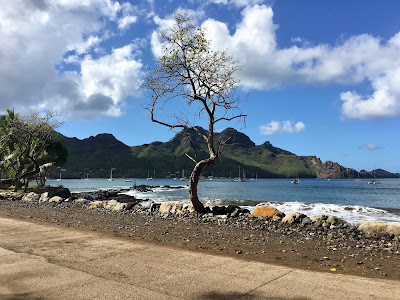
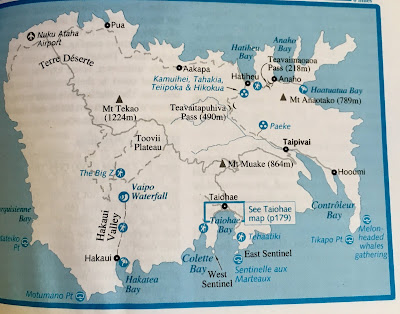
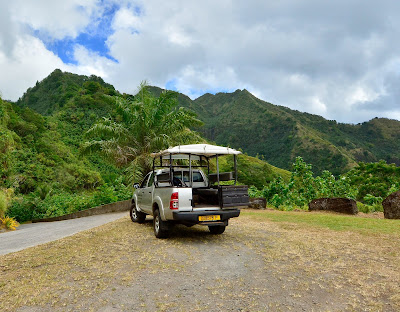


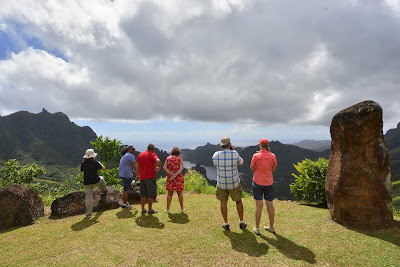

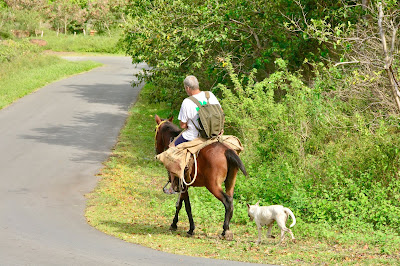







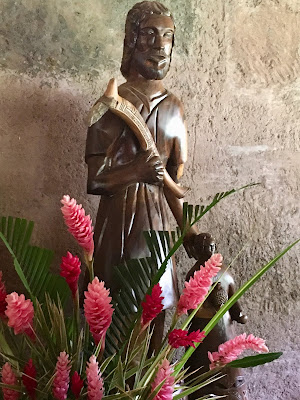

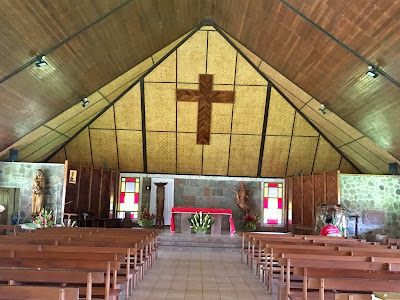

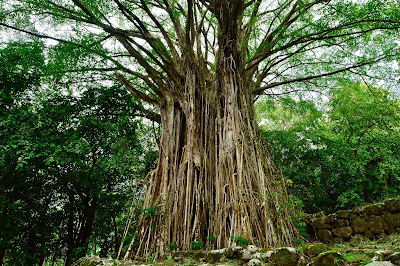


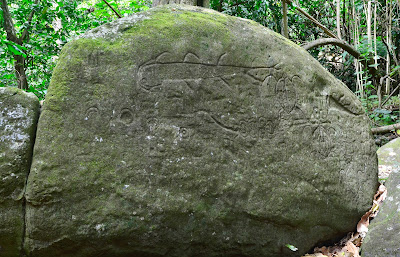
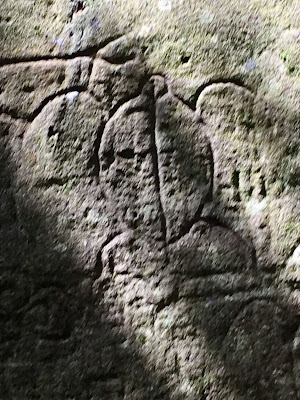
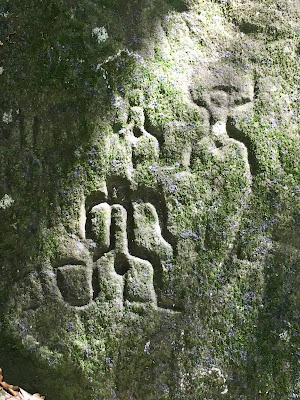


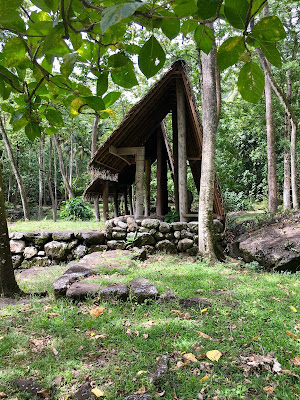
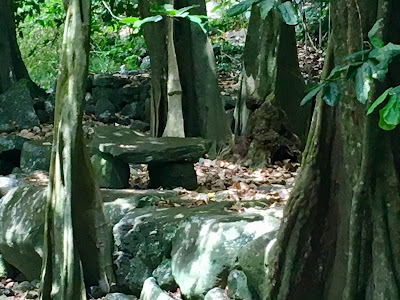
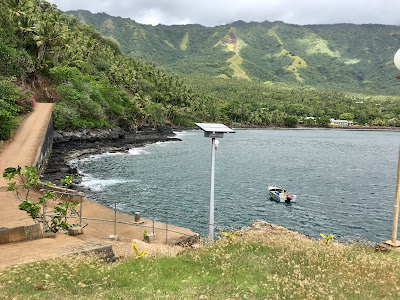








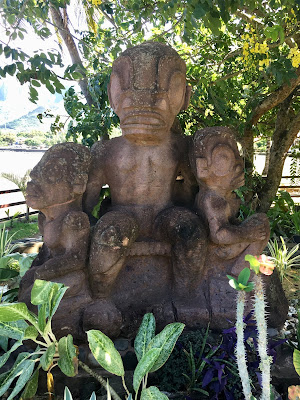



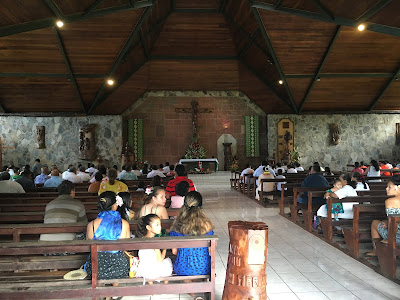

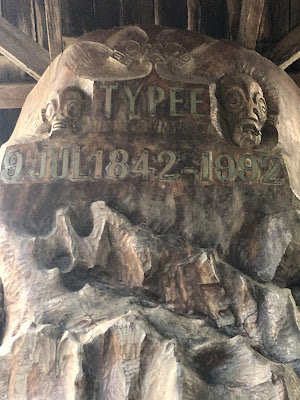
No comments:
Post a Comment